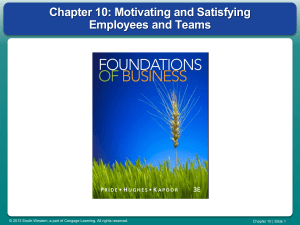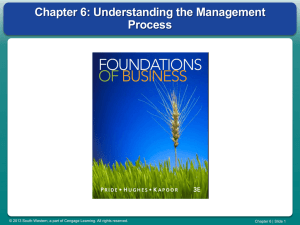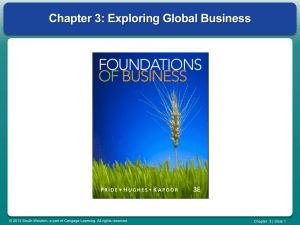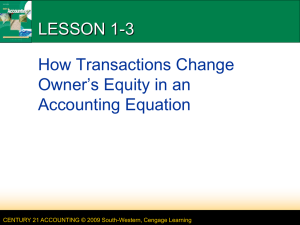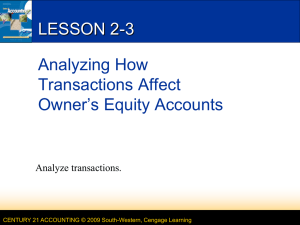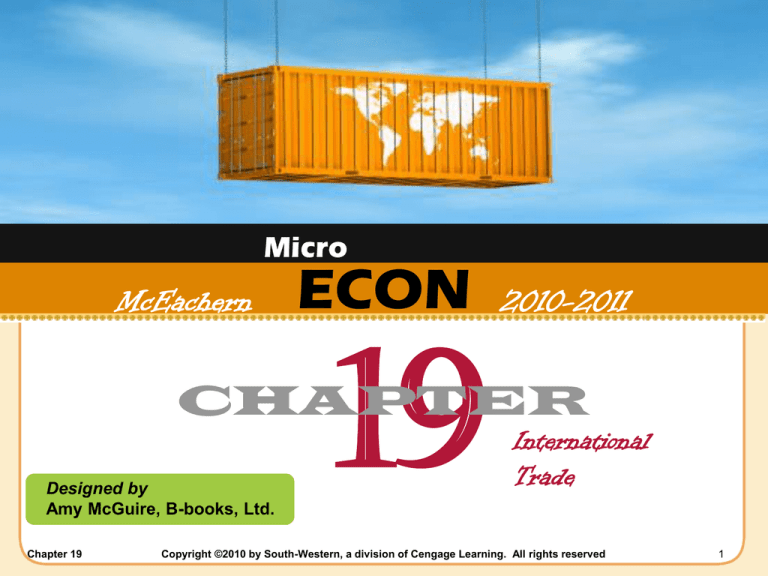
Micro
McEachern
ECON
19
2010-2011
CHAPTER
Designed by
Amy McGuire, B-books, Ltd.
Chapter 19
International
Trade
Copyright ©2010 by South-Western, a division of Cengage Learning. All rights reserved
1
The Gains from Trade
Law of comparative advantage
Countries specialize
– Goods with the lowest
opportunity cost
U.S. exports
– $1.6 trillion (12% of GDP) in 2007
• Services (30.2%)
U.S. imports
– $2.3 trillion (17% of GDP) in 2007
LO1 • Industrial supply (27.1%)
Chapter 19
Copyright ©2010 by South-Western, a division of Cengage Learning. All rights reserved
2
Exhibit 1
LO1
Composition of U.S. Exports and
Imports in 2007
Chapter 19
Copyright ©2010 by South-Western, a division of Cengage Learning. All rights reserved
3
Production Possibilities
Without Trade
Production possibilities
– With existing resources
No trade
– Production possibilities =
consumption possibilities
Production possibilities
frontier
LO1
Chapter 19
Copyright ©2010 by South-Western, a division of Cengage Learning. All rights reserved
4
Production Possibilities
Schedules for
United States and Izodia
Exhibit 2
LO1
Chapter 19
Copyright ©2010 by South-Western, a division of Cengage Learning. All rights reserved
5
Exhibit 3
LO1
Production Possibilities Frontiers for the United States
and Izodia Without Trade (millions of units per day)
500
Food
400
300
200
100
U1 (a) United States
500
U2
400
U3
U4
300
200
U5
100
U6
0
(b) Izodia
600
Food
600
100 200 300 400 Clothing
0
I1
I2
I3
I4
I5
I6
100 200 300 400 Clothing
Slope: opportunity cost of an additional
An additional unit of food costs 2 units of
unit of food is ½ unit of clothing
clothing.
Food is produced at a lower opportunity cost in the United States.
Chapter 19
Copyright ©2010 by South-Western, a division of Cengage Learning. All rights reserved
6
Consumption Possibilities
Gains from specialization and trade
– Each country should specialize
• Producing the good with the lower
opportunity cost
Terms of trade
Consumption possibilities frontier
– Possible combinations of good
• As result of specialization and
exchange
LO1 – Depend on relative preferences
Chapter 19
Copyright ©2010 by South-Western, a division of Cengage Learning. All rights reserved
7
Exhibit 4
LO1
Production (and Consumption) Possibility Frontiers
with Trade (millions of units per day)
(b) Izodia
(a) United States
600
600
500
500
U
300
200
U4
300
100 200 300 400 Clothing
I
200
100
100
0
400
Food
Food
400
0
I3
100 200 300 400 Clothing
Trade: 1 unit of clothing for 1 unit of food. Both countries are better off as a result of
international trade.
Chapter 19
Copyright ©2010 by South-Western, a division of Cengage Learning. All rights reserved
8
Reasons for International
Specialization
Differences in resource endowments
– Create differences in opportunity
cost
– Countries export
• Produce more cheaply
– Countries import
• Products unavailable
domestically
2 • Cheaper elsewhere
LO
Chapter 19
Copyright ©2010 by South-Western, a division of Cengage Learning. All rights reserved
9
LO2
Exhibit 5
U.S. Production as a Percentage of U.S.
Consumption for Various Commodities
If U.S. production is <100% of consumption, imports make up the difference.
If U.S. production exceeds U.S. consumption, then the difference is exported.
Chapter 19
Copyright ©2010 by South-Western, a division of Cengage Learning. All rights reserved
10
Reasons for International
Specialization
Economies of scale
– Firms produce more
– Reducing average costs
Differences in tastes
OR
?
LO2
Chapter 19
Copyright ©2010 by South-Western, a division of Cengage Learning. All rights reserved
11
LO3
Consumer and Producer
Surplus
Market exchange
Demand: marginal benefit
Consumer surplus
Difference between what
consumers would pay and
what they do pay
Supply: marginal cost
Producer surplus
Difference between actual
amount received and what
they would accept
Chapter 19
Copyright ©2010 by South-Western, a division of Cengage Learning. All rights reserved
12
Consumer and Producer Surplus
from Market Exchange
Consumer
surplus
Price per pound
Exhibit 6
LO3
$0.50
0.25
0
Chapter 19
S = marginal cost
Producer
surplus
D = marginal benefit
60
Chicken
(pounds per day)
Copyright ©2010 by South-Western, a division of Cengage Learning. All rights reserved
13
LO3
Trade Restrictions
Tariff: Tax on imports
Specific
$ amount per unit
Ad valorem
Percentage per unit
Effects
Loss of consumer surplus
Increase in producer surplus
Increase in government revenue
Net loss in domestic social welfare
Chapter 19
Copyright ©2010 by South-Western, a division of Cengage Learning. All rights reserved
14
Exhibit 7
LO3
Price
per pound
At a world P=$0.10 per pound, US consumers
demand 70 mill. pounds of sugar per month, and US
producers supply 20 mill. pounds per month; the
difference is imported.
$0.15
0.10
Effect of a Tariff
S
a
c
b
d
f
D
0
20 30
Tariff= $0.05 per pound; P=$0.15 per pound.
US producers increase production to 30 mill.
pounds; US consumers cut back to 60 mill.
pounds. Imports fall to 30 mill. pounds.
a = increase in producer surplus
60 70 Sugar millions of
pounds per month)
c = government revenue from
the tariff
b = higher marginal cost of domestically producing sugar
that could have been produced more cheaply abroad.
d = loss of consumer surplus from the drop in consumption
Consumers are worse off. Loss of consumer surplus: areas a, b, c, and d.
b+d = Net welfare loss to the US economy
Chapter 19
Copyright ©2010 by South-Western, a division of Cengage Learning. All rights reserved
15
LO3
Trade Restrictions
Import quotas
Legal limit on the amount of a
commodity that can be imported
Target imports from certain countries
Effects
Raise the U.S. price above the world price
Reduce quantity below the free-trade level
Lower consumer surplus
Increase in producer surplus
Net loss in domestic social welfare
Chapter 19
Copyright ©2010 by South-Western, a division of Cengage Learning. All rights reserved
16
Exhibit 8
LO3
$0.15
(a)
S
Price
per pound
Price
per pound
Effect of a Quota
S’
e
S
(b)
S’
$0.15
0.10
0.10
a
b
c
D
D
0
20
50
70 Sugar
(millions of pounds per month)
d
0
20 30
60 70 Sugar
(millions of pounds per month)
Quota=30 mill., world price=$0.10. S’=supply curve (imports and US production; new price
$0.15: intersection of D and S’.
Loss of consumer surplus: a+b+c+d; a = transfer from US consumers to US producers;
b+d = net loss; c = gain for sellers of foreign-grown sugar
Chapter 19
Copyright ©2010 by South-Western, a division of Cengage Learning. All rights reserved
17
LO3
Trade Restrictions
Quotas in practice
Rewards domestic and
foreign producers with higher
prices
Lobbyists for foreign
producers
Right to export to U.S.
Auction off the quotas
Increase federal revenue
Reduce pressure to
perpetuate quotas
Chapter 19
Copyright ©2010 by South-Western, a division of Cengage Learning. All rights reserved
18
LO3
Trade Restrictions
Comparison: Tariffs and Quotas
Similarities
Higher price
Lower quantity demanded
Loss of consumer surplus (U.S. Consumers
Gain of producer surplus (U.S. producers)
Lower economic welfare
Differences
Revenue from tariff – U.S. government
Revenue from quota – to quota rights’ owner
Chapter 19
Copyright ©2010 by South-Western, a division of Cengage Learning. All rights reserved
19
LO3
Other Trade Restrictions
Export subsidies
Domestic content requirements
Other requirements
Health
Safety
Technical standards
Bilateral agreements
Trade restrictions
Slow economic progress
Chapter 19
Copyright ©2010 by South-Western, a division of Cengage Learning. All rights reserved
20
Multilateral Agreement
General Agreement on Tariffs and Trade
GATT:
• Reduce tariffs
• Reduce import quotas
• Equal trade
1986, “Uraguay Round”
• 140 countries
• Successor: WTO
LO4
Chapter 19
Copyright ©2010 by South-Western, a division of Cengage Learning. All rights reserved
21
The World Trade Organization
Legal and institutional foundation for world trade
500 economists and lawyers
Trade
Merchandise
Services
Intellectual property
Phase out quotas
Keep only tariffs
LO4
Chapter 19
Copyright ©2010 by South-Western, a division of Cengage Learning. All rights reserved
22
Case Study
LO4 Doha Round and Round
Chapter 19
1999, WTO, Seattle
50,000 protesters
Largest demonstration against free
trade
Labor union;
Environmental;
Farmers
Labor and
environmental
standards
Failed to get off
the ground
Copyright ©2010 by South-Western, a division of Cengage Learning. All rights reserved
23
Case Study
LO4 Doha Round and Round
Chapter 19
2001, Doha, Qatar “Doha Round”
Improve market access
Phase out export subsidies
Reduce subsidies in agriculture
2003, Cancun
2005, Hong Kong
2007, Germany
Round and round
Copyright ©2010 by South-Western, a division of Cengage Learning. All rights reserved
24
Common Markets
U.S. economy
Free trade zone across 50 states
European Union
27 countries in 2007
Barrier-free European market
16 members: common currency – Euro
North American Free Trade Agreement
United States, Canada, Mexico
LO4
Chapter 19
Copyright ©2010 by South-Western, a division of Cengage Learning. All rights reserved
25
Common Markets
DR-CAFTA
U.S., Dominican Republic, five Central
American countries
Mercosur
Latin American countries
ASEAN
Southeast Asian nations
Southern African Customs Union
LO4
Chapter 19
Copyright ©2010 by South-Western, a division of Cengage Learning. All rights reserved
26
Arguments for Trade
Restrictions
National defense argument
– More efficient
• Government subsidies
• Stockpile
Infant industry argument
– Foster inefficiencies
– More efficient
• Temporary
production
subsidies
LO5
Chapter 19
Copyright ©2010 by South-Western, a division of Cengage Learning. All rights reserved
27
Arguments for Trade
Restrictions
Antidumping argument
– Dumping
• Sell a product abroad for less than in
the home market
• Persistent
• Consumers – pay less
• Increase consumer surplus
• Predatory
• Temporary; eliminate competitors
• Sporadic
LO5
Chapter 19
• “sales”
Copyright ©2010 by South-Western, a division of Cengage Learning. All rights reserved
28
Arguments for Trade
Restrictions
LO5
Chapter 19
Jobs and income
– Protect domestic jobs
– Retaliation
– Great Depression:
high tariffs choked
trade and jobs
Declining industries
argument
– Help lessen shocks to
the economy
– Specific duration
Copyright ©2010 by South-Western, a division of Cengage Learning. All rights reserved
29
Problems with Trade
Protection
Protect one stage of production
– Protect downstream stages
Cost of protection
– Welfare loss
– Cost of rent seeking
Transaction cost of enforcing restrictions
– Black markets
Less efficient, less innovative
Retaliation
LO5
Chapter 19
Copyright ©2010 by South-Western, a division of Cengage Learning. All rights reserved
30
Case Study
LO5 Steel Tariffs
Chapter 19
U.S. steel industry
Slow to adopt new
technologies
Long and painful decline
2002: tariffs on imported steel
Helped U.S. steel industries
Cut imports; Boosted U.S.
price of steel
Hurt U.S. steel-using
industries
Less competitive
Cost: 15,000 to 20,000 jobs
Copyright ©2010 by South-Western, a division of Cengage Learning. All rights reserved
31
Case Study
LO5 Steel Tariffs
Chapter 19
Expected retaliation
European Union
Threat to impose tariffs on U.S. exports
WTO
The tariffs = violation of trade agreements
Japan, South Korea
Threat to impose tariffs on U.S. exports
December 2003
U.S. repealed the steel tariffs
Copyright ©2010 by South-Western, a division of Cengage Learning. All rights reserved
32

